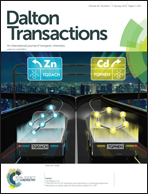Multicolor (Vis-NIR) mesoporous silica nanospheres linked with lanthanide complexes using 2-(5-bromothiophen)imidazo[4,5-f][1,10]phenanthroline for in vitro bioimaging†
Abstract
A novel mesoporous nanosphere functionalized with 3-(aminopropyl)triethoxysilane (APTES) and 2-(5-bromothiophen)imidazo[4,5-f][1,10]phenanthroline (5-Br-Tip) was synthesized (denoted as Tip-MSS). With the coordinating function of the 5-Br-Tip to lanthanide (Ln) ions, for the first time, LnL3(5-Br-Tip) complexes were linked to the mesoporous nanospheres. The derived materials, named Ln-Tip-MSS (Ln = Eu, Tb, Sm, Nd, Yb), were characterized by Fourier-transform infrared (FT-IR) spectroscopy, TEM, XRD (wide-angle and small-angle), N2 adsorption/desorption analysis, and fluorescence spectroscopy. Upon excitation in the ligand absorption, the Ln-Tip-MSS nanomaterials show characteristic visible (Eu, Tb, Sm) and NIR (Sm, Nd, Yb) luminescence (multicolor emission covered from 450 nm to 1400 nm spectral region). Of importance is that, with low cytotoxicity and good biocompatibility given by the methyl thiazolyl tetrazolium (MTT) assay, the Eu-Tip-MSS was successfully applied to cell imaging in vitro based on the Eu3+ luminescence (under 405 nm excitation).
![Graphical abstract: Multicolor (Vis-NIR) mesoporous silica nanospheres linked with lanthanide complexes using 2-(5-bromothiophen)imidazo[4,5-f][1,10]phenanthroline for in vitro bioimaging](/en/Image/Get?imageInfo.ImageType=GA&imageInfo.ImageIdentifier.ManuscriptID=C4DT02444C&imageInfo.ImageIdentifier.Year=2015)

 Please wait while we load your content...
Please wait while we load your content...